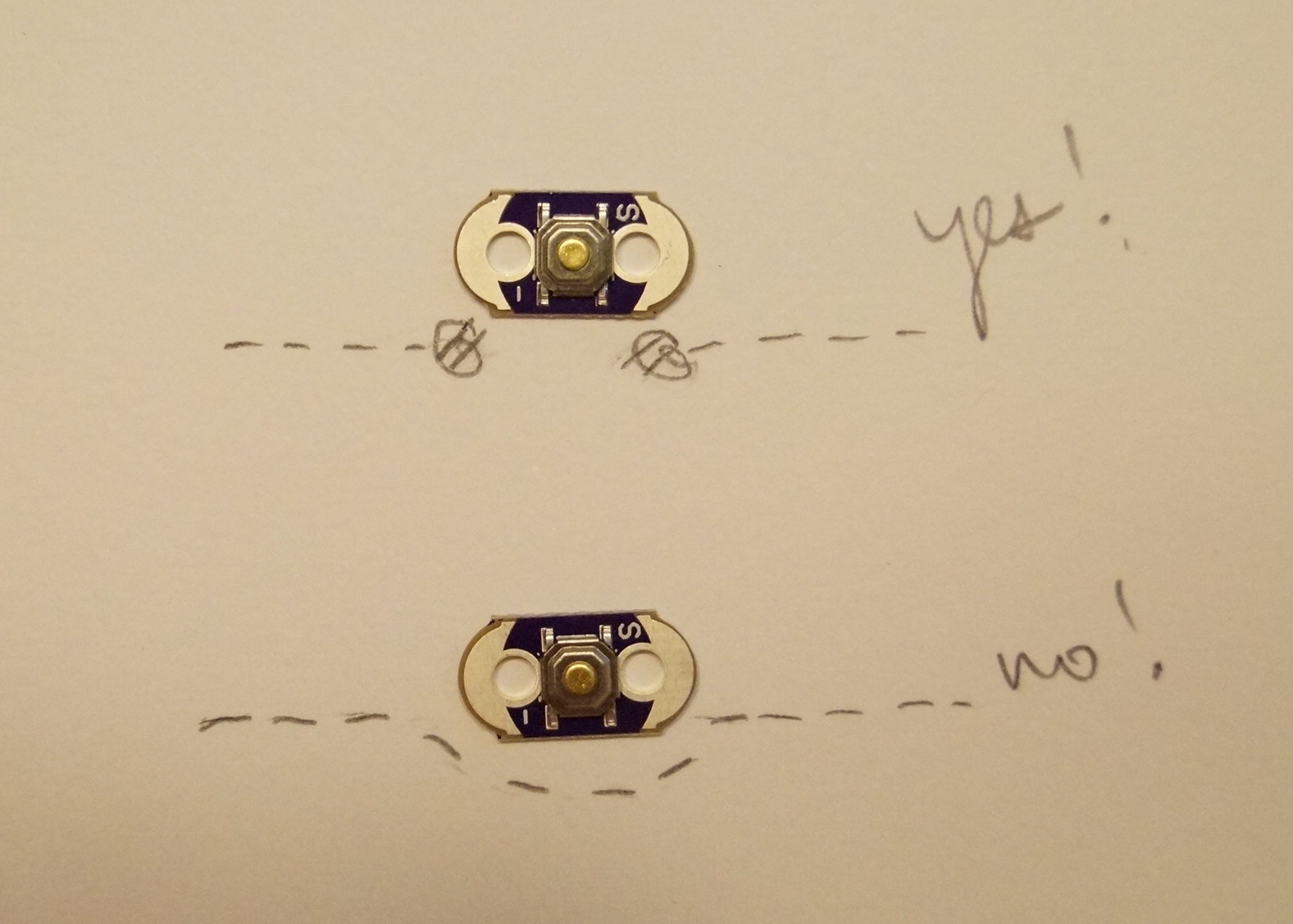Tips and Troubleshooting
Conductive Thread Sewing Tips
-
 Use beeswax to coat thread. Conductive thread is “hairy” which causes it to stick to itself and twist up. The wax will make it easier to handle and easier to thread through a needle.
Use beeswax to coat thread. Conductive thread is “hairy” which causes it to stick to itself and twist up. The wax will make it easier to handle and easier to thread through a needle. -
 Waxed conductive thread on left, un-waxed conductive thread on right
Waxed conductive thread on left, un-waxed conductive thread on right -
Keep conductive thread to a manageable length. For these workshops, about a foot or arm’s length of conductive thread is enough for each connection.
-
When working with regular thread it is common practice to double the thread, but with conductive thread only a single strand is necessary. Think of conductive thread like a wire, the purpose is to conduct electricity rather than hold fabric together.
 Use only a single strand of conductive thread and make a double (or triple) knot at one end, keeping about a 3” tail so the needle doesn’t slip off.
Use only a single strand of conductive thread and make a double (or triple) knot at one end, keeping about a 3” tail so the needle doesn’t slip off.-
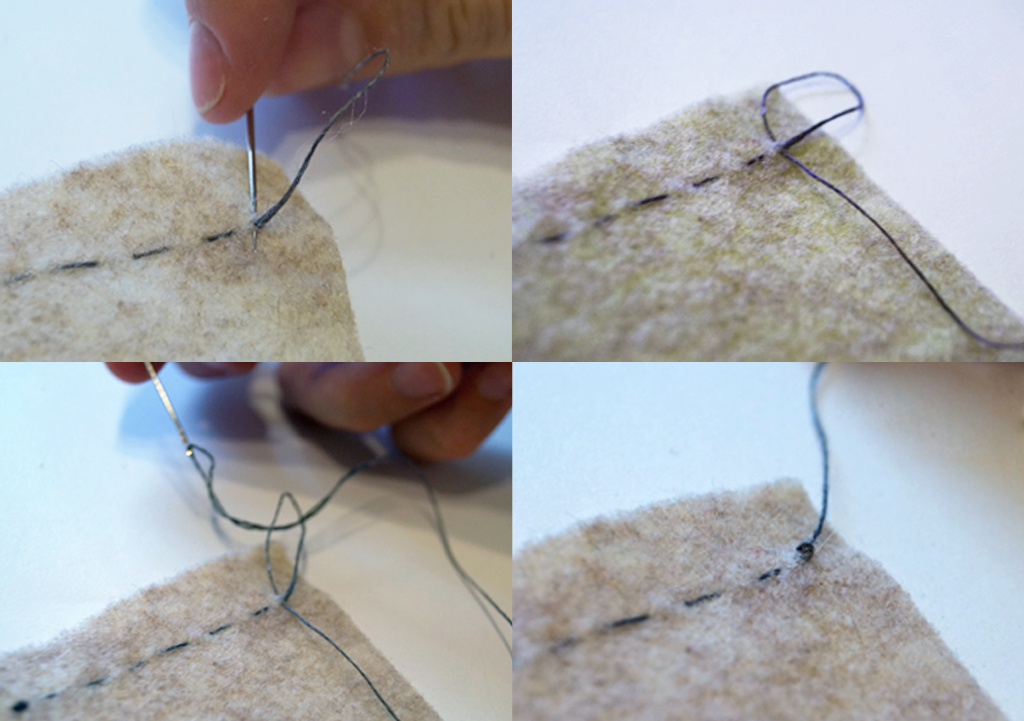 Double knot and trim conductive thread when finishing a stitch. If knots aren’t trimmed the tails can create a short circuit.
Double knot and trim conductive thread when finishing a stitch. If knots aren’t trimmed the tails can create a short circuit. -

-
Keep work area clear. Conductive thread that has been trimmed may stick to your fabric and cause a short circuit.
 Apply clear nail polish to all trimmed knots of conductive thread once the circuit is complete. This will keep the knots from coming undone.
Apply clear nail polish to all trimmed knots of conductive thread once the circuit is complete. This will keep the knots from coming undone.
How to Make a Felt Bridge
-
Using regular (non-conductive) thread, stitch a small piece of felt over the conductive thread you need to cross. Use that piece of felt as a “bridge” when you begin stitching with conductive thread to the part of the circuit you need to reach.
-
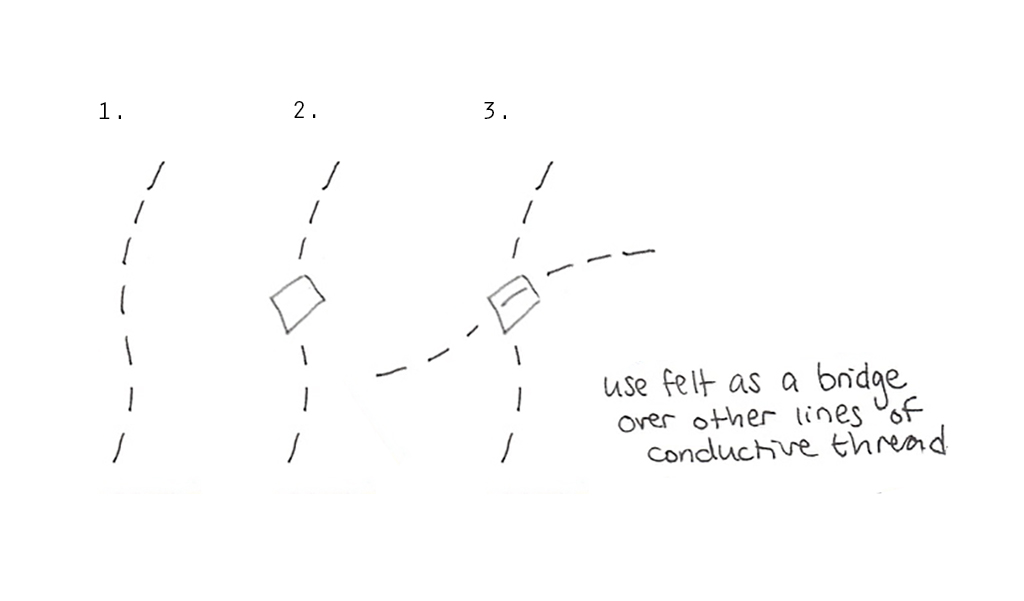
-
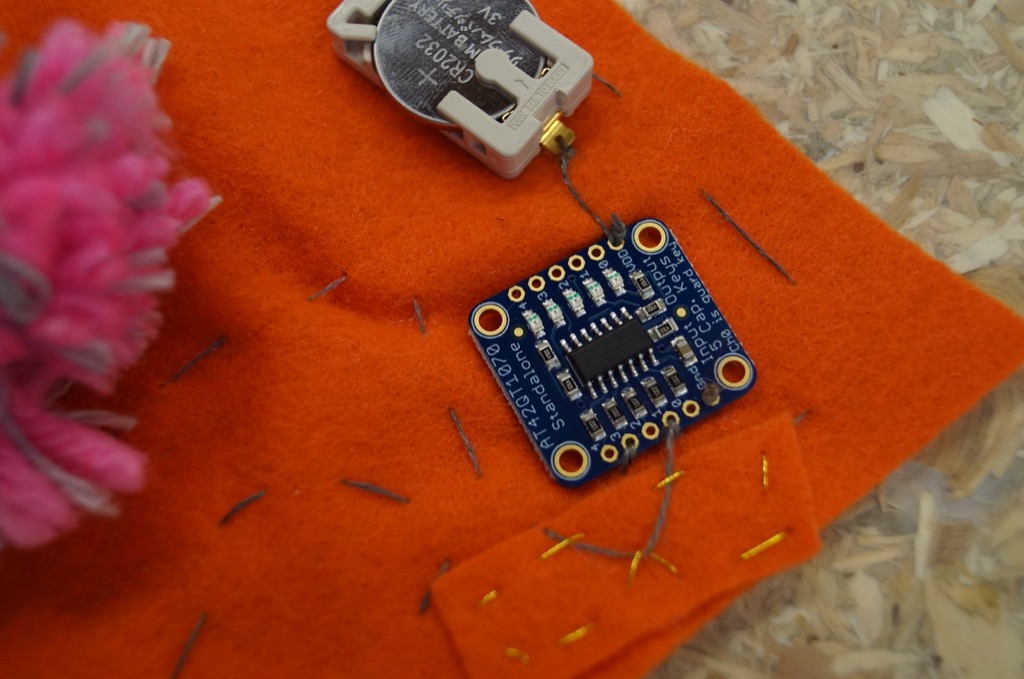 Above image: A student’s felt bridge from Getting Hands On With Soft Circuits: Pom Poms at Marwen. The gold thread is non-conductive.
Above image: A student’s felt bridge from Getting Hands On With Soft Circuits: Pom Poms at Marwen. The gold thread is non-conductive.
Working with LEDS
-
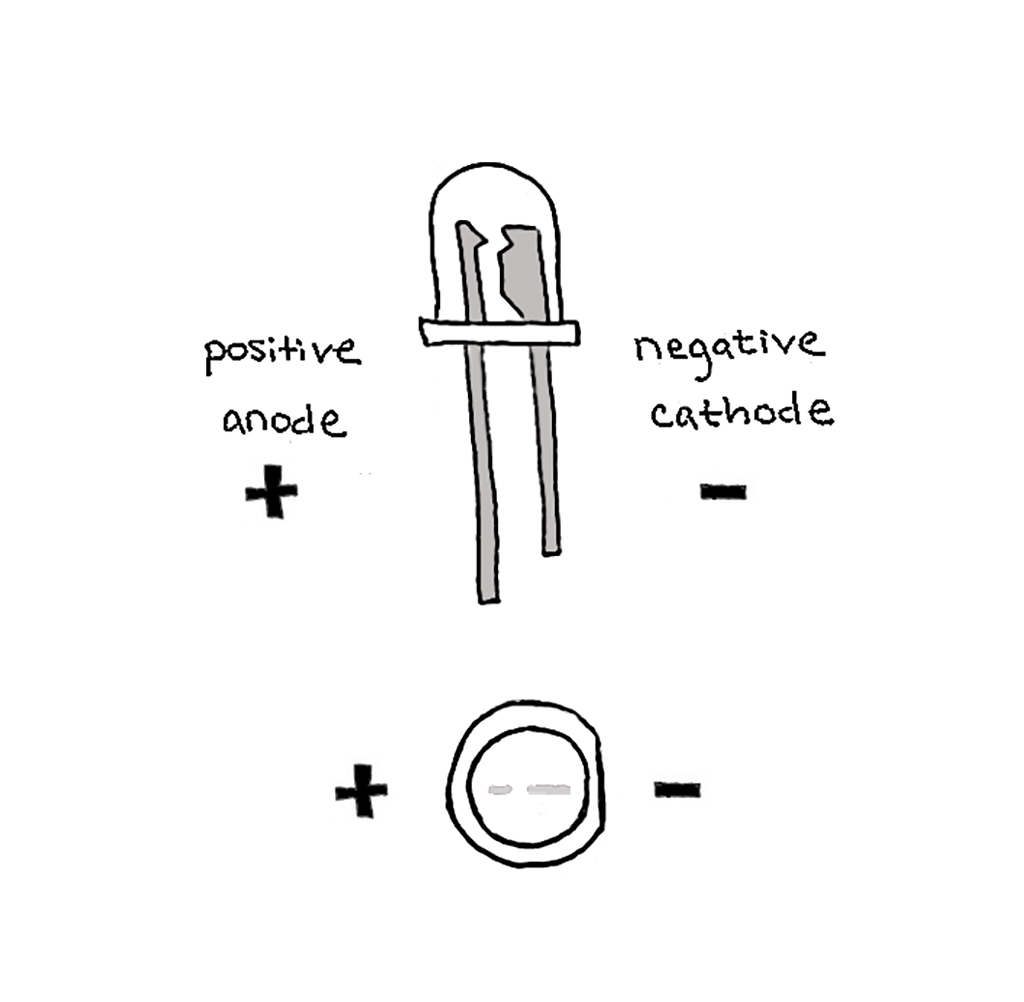
-
LEDs are light emitting diodes
-
Diodes have polarity meaning they only allow current to pass through them in one direction.
Use the following methods to identify LED polarity:
-
A common type of LED has two “legs” one short and one long. The short leg is negative and the long leg is positive. For these workshops we have coiled the legs to make the LEDs easier to sew (which in turn makes identifying polarity at a glance more difficult). In our tutorial images we have colored the positive coiled leg with red permanent marker.
- Look closely at the LED, you should be able to see into the clear epoxy dome and see two “flags”. The wider of the two flags is the negative and the thinner flag is positive.
- Another way to identify polarity is by looking for the flat side of the LED’s epoxy dome. Looking down at an LED you will notice it is not circular. The flat side is the negative side. It might be easier to feel the flat side than to see it.
How to coil LED legs from Jenna Boyles on Vimeo.
Working with Wire
-
For some soft circuit projects you will find insulated wire is the more appropriate to use in place of conductive thread. Wire must be used for connections in the Metamorphic Color project for instance, to direct current from the battery to the proper part of the circuit. Conductive thread would heat up too quickly for the project because it is more resistant than wire.
-
A wire stripper is a tool used to strip plastic insulation off of wire without cutting the wire.
- A notch or notches in the tool correspond to the gauge of wire being stripped.
- Some wire strippers, such as the pair pictured below, have a plier tip. Like a pair of needle nose pliers, a wire stripper with this feature can be used to coil ends of wire or LEDs to make connections with thread. (See video above)

Tips for Touch Sensor AT42QT1070
-
Make sure you stitch conductive thread to the proper pins. If you stitch your sensors to the output pins the circuit will not work.
-
Stitching the board in place with regular thread through the larger pin holes in each corner can be helpful before you begin stitching with conductive thread.
- Since the input pins are close together, we recommend using every other input pin. This helps keep knots of conductive thread from touching each other. In the images below, input pins 1 and 3 are used.
-
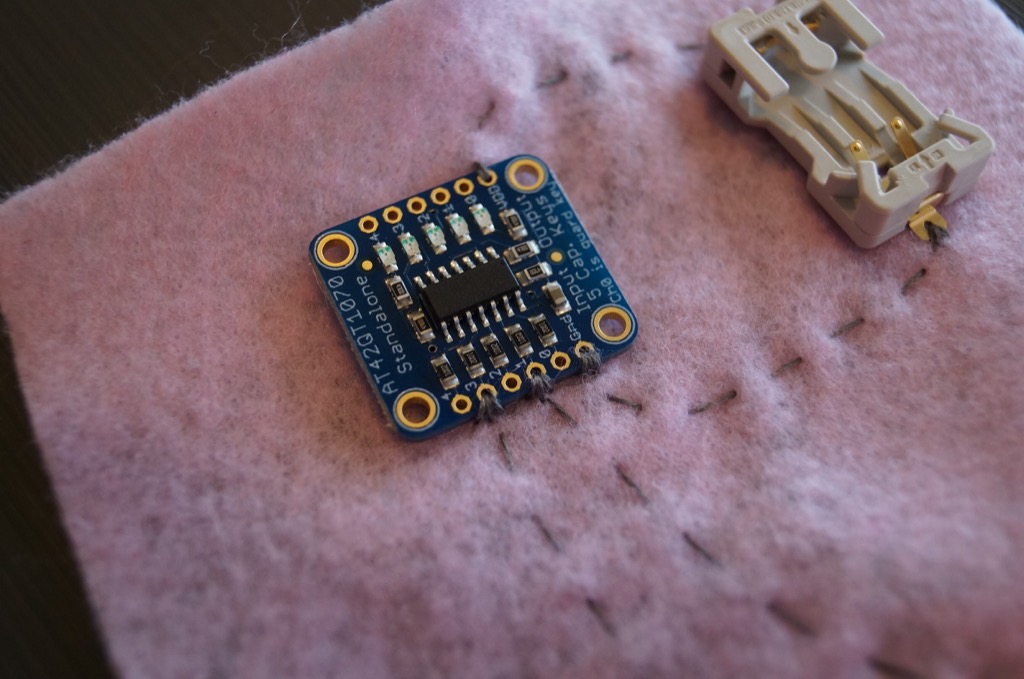
-
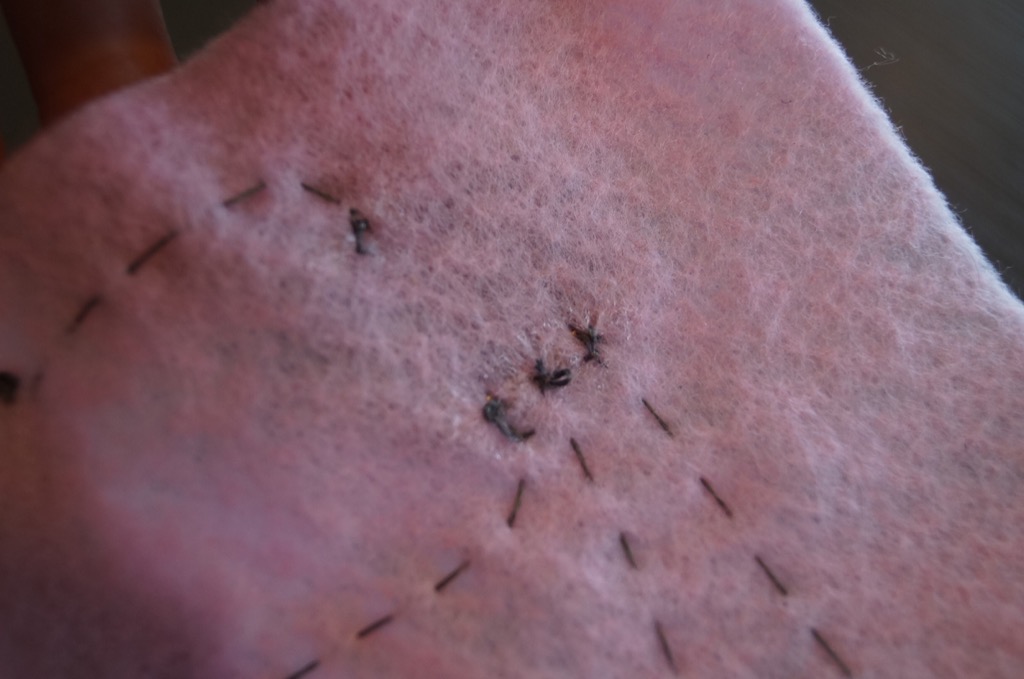
- A felt bridge is recommended to keep connections isolated if you want to use all 5 inputs.
-
In the image below, the three visible knots stitched through a felt bridge are connected to input pins 2, 4, and GND. The knots of conductive thread connected to pins 1 and 3 are under the felt bridge.
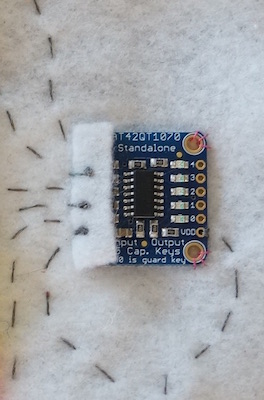
Troubleshooting
Circuit isn’t working? It could be one of the following common issues.
A common mistake when new to stitching soft circuits is to stitch through a component with the same piece of thread as if sewing on a bead or button. This will not allow current to pass through the component because the current will take the path of least resistance - the stitches that pass under the component. When sewing on a component, always stitch a few times into the component, knot, and trim conductive thread before stitching the other end of the component in place with a new piece of conductive thread.
Component orientation
-
An LED is a diode, which means it will only allow electricity to flow in one direction (think of it like a pet door that only lets your pet out, but not in). Similarly, if the positive end of the LED is stitched to the negative end of the battery pack, current will not flow through the LED. If your LED is not lighting up ensure that it is correctly oriented with its polarity matching that of the battery.
-
Have you stitched to the proper pins on the AT42QT1070 touch sensor? The conductive yarn and thread should be leading to the input pins, the LEDs are outputs.
Voltage and current
- Series vs parallel
- Only if current exceeds the forward voltage of the LED can it travel through.
Short circuits
Check to make sure there are no stray trimmings of conductive thread stuck to the back of your circuit (this can cause current to bypass the LED by creating a short circuit). Similarly, if you accidentally stitch through a component with the same piece of conductive thread (illustrated with the image of the button above) current will flow through the path of least resistance (the thread) and bypass the component. A loose knot could also be the issue. Always double knot when tying off conductive thread. Knots can be sealed with clear nail polish to keep from coming undone.
